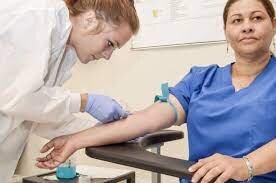Might it be said that you are thinking about How Long Does It Take to Become a Phlebotomist? Provided that this is true, you may be considering the way in which long it takes to become one. In this article, we’ll investigate the way to turn into a phlebotomist and give you all the data you really want to get everything rolling on this compensating venture.
How Long Does It Take to Become a Phlebotomist
While considering a vocation as a phlebotomist, the excursion starts with a strong instructive establishment. A secondary school recognition or its same, the Overall Instructive Turn of Events (GED) endorsement, fills in as the underlying venturing stone. Let’s come to our main topic which is about How Long Does It Take to Become a Phlebotomist?

Education Requirements for Phlebotomist
To become a Phlebotomist you only have to complete the given education and training program.
- High School Diploma or Equivalent
- Phlebotomy Training Program
- Certification
- Clinical Experience
Phlebotomy Training Length
Whenever you’ve finished secondary school, the following stage is signing up for a phlebotomy preparation program. These projects are intended to furnish you with the fundamental information and abilities expected for the gig. The term of these projects can fluctuate however frequently ranging from 1 month or 45 days. During your preparation, you’ll cover a scope of points, including life systems, physiology, venipuncture strategies (the craft of drawing blood), and contamination control. Additionally, you will acquire useful communication skills for working with patients, which is an essential aspect of the job. Also, read List of Awards for High School Students.
Clinical Experience
After completing your classroom education, you’ll transition to the clinical phase of your training. This is where you gain hands-on experience in a real healthcare setting. Under the guidance of experienced phlebotomists, you’ll apply what you’ve learned in a practical setting. This experience can be incredibly valuable and may take 2 to 4 months to complete, depending on the program.
How Long Does Phlebotomy Certification Take
When you’ve effectively finished your preparation and clinical experience, the last step is acquiring accreditation. The certificate is a proper acknowledgment of your abilities and information as a phlebotomist. The majority of phlebotomists seek certification from reputable organizations like the American Society for Clinical Pathology (ASCP) or the National Phlebotomy Association (NPA), despite state-specific requirements. To accomplish a certificate, you’ll commonly have to breeze through a test that surveys your phlebotomy abilities and information. Get the answer Are There Any HBCU In California.
How Long Is the Phlebotomy Course
Presently, we should separate the timetable for turning into a phlebotomist, zeroing in on schooling and preparing, clinical experience, and confirmation.
- Education and Training Program: Completing a phlebotomy training program can take anywhere from 4 to 8 weeks
- Clinical Experience: The clinical experience phase typically ranges from 2 to 4 months
- Certification: After finishing the training program and clinical experience, individuals can take the certification exam, which may require additional preparation time.
Overall it takes 6 months to 1 year to become a certified phlebotomist
After effectively finishing your phlebotomy preparation program and clinical experience, now is the ideal time to seek accreditation. While certificate necessities differ by state, most phlebotomists look for affirmation through associations like the American Culture for Clinical Pathology (ASCP) or the Public Phlebotomy Affiliation (NPA). The certificate cycle regularly includes finishing a test that tests your insight and abilities. Hope you can understand all the points about How Long Does It Take to Become a Phlebotomist? In the excursion to turn into a phlebotomist, I’ve shared the means, the highs, and the commitment. It’s your way to a remunerating medical services profession.